 |
|
PART 1 - Ascidians, Botryllus |
|
||||
| Among zooplankton we
can find many animals in a larval stage. Larval appearance often completely
differs to that of the adult and species can be very difficult to recognize.
Sometimes we find only eggs which are much more difficult to identify.
Some of them may be tunicate eggs which, if they have been fertilized and
if you conserve them in a favorable environment, larvae will hatch and
begin their development. Tunicate growth includes metamorphosis which is
very intriguing to observe.
Some Tunicate larvae: |
 |
| Though I like to observe marine life, my knowledge on this subject is limited: I am not, alas, a specialist in marine biology. It would be presumptuous for me to make a lesson on this topic: excellent articles have been already published in Micscape: (see links below). Yet I have had opportunity to take pictures of members from the tunicate family and I want to share them with other readers which reside far from the sea. |
| Many times, I have found
some eggs of Ascidians (member of the tunicate family) at various development
stages. (Picture above). Ascidians are amazing marine animals often called
'sea squirts', because they spit water when they are disturbed. Their adult
appearance may be sometimes a little repelling. Some members of the ascidian
family remain transparent with a very delicate appearance e.g. the CLAVELINS,
but others have calcified or opaque tunics which look rather like a potato.
By keeping the eggs in a culture box or a Petri dish in the vegetable compartment of a refrigerator (temperature around 12 °C), I have conserved them for 3 weeks while observing successive phases of growth. Ascidians filter sea water into a double layered envelope. The thick external wall is called the tunic and the inside layer is pierced by gill slits which circulate water. One input orifice (the incurrent siphon) and one output (excurrent siphon) complete the hydraulic circuit. Nutrients are captured and brought into the stomach by the endostyle, which is a mucus secreting structure above the slit layer. When they are young, the tunic - which is made from a material near to cellulose (an unusual material in the animal kingdom) - remains transparent and all internal organs can be seen easily. |
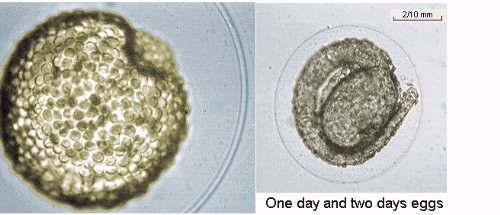 |
One day and two day old ascidian eggs. Picture below, one day old larva: |
 |
| As you can see in the picture above, after two or three days the larva looks like a 'tadpole'. It swims a little using its tail which possesses a rudimentary nervous system and organ called the NOTOCHORD which is a common feature in the life cycle of the vertebrate (CHORDATE) branch of the animal kingdom. In the picture, the black dot in the head is an organ of equilibrium called the STATOLITH, the smaller is an ocellus (simple eye). On the left side 'suckers' will help the animal adhere to rocks, boat hulls ... tunicates are very common in harbors. If the substrate is adequate, the animal attaches itself and metamorphosis begins. But if your culture box is not agitated they don't fix themselves strongly and it is possible to transfer it into a depression slide (or a well slide) for more convenient observation. The tail is resorbed in three or four days (darkfield picture below) and the first two gill slits can be seen with the two siphons. (The picture below shows specimens 10 days old with retracted siphons; it doesn't like its transfer to the slide!) The digestive system, gut, stomach and heart which pumps alternately one way then the other, are enlarged in the picture (See video clip). |
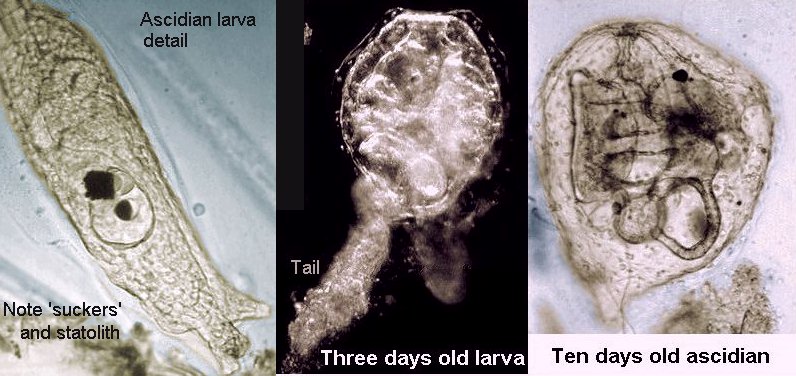 |
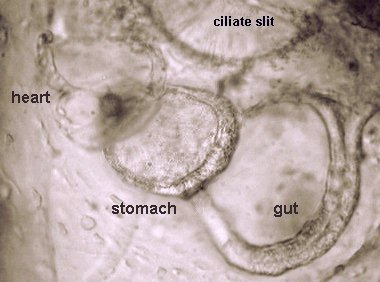 |
Close up view (15x objective) of internal organs of a ten day old ascidian from picture above. |
| After ten days
the general appearance does not change and I have released specimens.
Another time I have found an older specimen in my plankton net, (probably 2 or 3 months old) with a size of about 3 - 4 mm, (too large for my low power objective), and I have made a montage below of seven component pictures. Internal organization is clearly visible, (see also schematic drawing at right side). The heart is difficult to see because the structures are very transparent: in fact it's only visible because it is moving. CLICK HERE TO SEE A YOUNG TUNICATE |
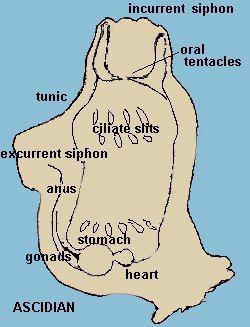 |
| Another type of tunicate lives in colonies: e.g. BOTRYLLUS which are often called moss animals, because they look plant-like. They often have bright colours; red or orange and all individuals are arranged in crowns around a common excreting siphon, like flower petals. They are easily found on mussel shells and algae ...Internal organisation is similar to ascidians, with a tunic and gill slits inside. But the tunic material is less transparent because it contains colored inclusions and only the input siphon can be seen clearly. Internally we can sometimes observe larvae which are released into the water and swim away to create a new colony. The (video clip) shows a 'dive' into an incurrent siphon made by continuous focusing: the upper focus point shows the six part orifice, a little below - the internal oral tentacles and at deepest focus - the gill slits. | ||
| I have put a colony into a jar and a day later I have found two swimming larvae. | ||
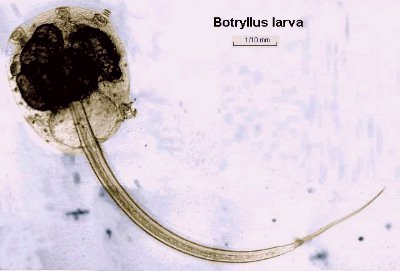 |
The picture left is a montage of 5 picture elements: three 'suckers' are clearly visible on the larva's upper body. | |
| On one occasion, I released larva into a jar, but I was very busy in my job during the week so I could only observe the jar five days later. I was surprised to see on the glass wall, two new colonies each with two individuals, probably generated by the two larvae. With care, I have aspirated one with a pipette to take the picture below. It's best to leave the animal alone for a while otherwise its body remains contracted with siphon closed. You can see the tunic has protrusions which are used to fix itself to objects. This stage is especially interesting for us because the tunic has not yet many colored inclusions and internal organization of individuals may be seen more easily. | ||
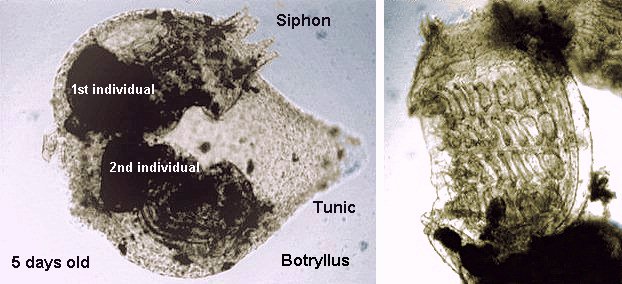 |
Note the four rows of gill slits on right hand picture. | |
| GO TO PART 2 to see other interesting members of the tunicate family: Salps, Doliolids and Larvaceans. | ||
|
R. HOWEY's articles , particularly : ' Tunicates with salad on the side' 'Sea squirts our distant cousins' : Wim VAN EGMOND - Jan PARMENTIER 'Botryllus' : Jan PARMENTIER Comments to the author Jean-Marie Cavanihac are welcomed. Microscopy
UK Front Page
All photographs © Jean-Marie Cavanihac 2000 Published in the December 2000 edition of Micscape Magazine. Please report any Web problems or offer general comments
to the Micscape
Editor,
Micscape is the on-line monthly magazine of the Microscopy
UK web
|
||